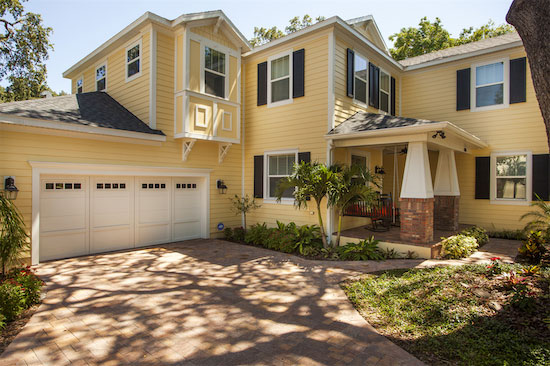There are many different types of siding for your home. Each offer benefits and disadvantages. Your choice of materials depends on many factors, including the architectural style of your home, the look you are seeking, how much time you want to spend on maintenance, and your budget. Let’s look at the most popular siding choices: vinyl, fiber cement, stucco and wood.
Vinyl
Vinyl is a popular siding material that is affordable and durable. Vinyl lasts for about 30 to 40 years and requires very little maintenance – it can be cleaned with soap and water! You can get vinyl siding in a wide range of colors and textures, and even with insulated backing to help with energy efficiency. One drawback of vinyl is that is can crack, and repairs often involve replacing an entire section.
Fiber Cement
Fiber cement is the fastest growing siding choice in America, with more than 8 million installations! Fiber cement is comprised of sand, cellulose, and cement that is compressed under extreme heat and pressure to form a sturdy, durable solid. The James Hardie® Fiber Cement siding installed by Amazing Exteriors comes with a 30-year warranty. It can be formed with a realistic wood texture. But, unlike wood, fiber cement is fireproof, insect-proof, and water-resistant. Because the color of fiber cement siding is “baked in” at the factory, it holds up well and doesn’t need refinishing for many years. Fiber cement siding is slightly higher in cost than vinyl, but similar to wood and stucco. Not all siding contractors have the experience necessary to properly install fiber cement siding.
Stucco
Stucco siding consists of a mixture of cement, water, and sand. Stucco can be applied in a rough or smooth finish. A metal framework is typically placed on a home’s exterior walls before applying stucco to give it something to adhere to. Stucco is a fairly inexpensive siding materials and is also fire-resistant and a good for insulation. But stucco does not hold up well in damp or humid climates, and is prone to cracking and splitting.
Wood
Wood siding has a natural and organic look. Wood siding is typically made from redwood, cedar, or pine. Wood siding needs to be painted or stained to preserve its integrity, which is one of its drawbacks – the painting or staining needs to be done again every few years, which can add significantly to its lifetime expense. Wood siding is not resistant to fire, water, or insects, making it susceptible to damage.
Contact Amazing Exteriors for Expert Siding Replacement
No matter which siding material you choose, you’ll get the highest quality professional installation from Amazing Exteriors. Call us to schedule a free in-home analysis.















